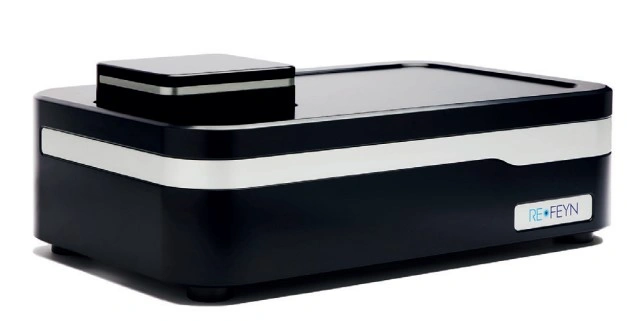
Instrument specification
Refeyn Two mass photometer is used to accurately measure the mass of single particles or biomolecules, using a light scattering approach. It can accurately determine the mass of proteins as small as 20kDa. Using this approach, proteins, single particles, and other biomolecules can be characterized to study their function, interactions, oligomerization, and macromolecular assembly. This technique helps to assess sample integrity and homogeneity, in a facile and label-free method. As the instrument can gather data over time, it enables capturing the dynamic behavior of molecules or particles.
Mass Photometer
Technicalities
Mass photometry is quantitative mass imaging of single macromolecules in their true native state. It uses a light-scattering approach which allows for rapid measurement of the mass of individual proteins or particles. This technique provides high resolution, enabling the detection of low-abundance species, and has a wide working mass range. Using this tool, reliable measurement of molecular mass in the range of 30 kDa to 5 MDa is possible.
Notably, the mass photometry resolution varies across the mass range and can be affected by the composition and quality of a sample.
It is operable in a wide range of buffers. It can measure proteins on lipid bilayers and membrane-mimetic systems as well. For the TwoMP mass photometer, at the lower end of the mass range, the resolution is ± 25 kDa for a measurement of a 66 kDa biomolecule (defined as the Full Width of the peak at its Half Maximum value, FWHM). At the higher end of the mass range, for example, 660 kDa, the resolution is ± 60 kDa FWHM.
Key features of Refeyn Two mass photometer
Mass photometry is quantitative mass imaging of single macromolecules in their true native state. It uses a light-scattering approach which allows for rapid measurement of the mass of individual proteins or particles. This technique provides high resolution, enabling the detection of low-abundance species, and has a wide working mass range. Using this tool, reliable measurement of molecular mass in the range of 30 kDa to 5 MDa is possible.
- Mass range: 30 kDa – 5 MDa
- Mass precision: ±2% or lesser
- Mass error: ±5% or lesser (single measurement)
- Resolution (FWHM): 25 kDa @ 66 kDa and 60 kDa @ 660 kDa
- Concentration range: 100 pM – 100 nM
- Sensitivity: << 1 ng of protein
- Wavelength: 488 nm
- Field of view: 4 x 11 µm (@ 500 Hz) up to 12 x 17 µm (@ 135 Hz)
- Pixel size: 12 nm
Theory of operation
The mass photometry, a tool for “watching protein’s weight,” carefully measures light scattering and provides information on the mass of macromolecules and complexes. Unlike other light-based techniques, the mass photometry signal measured is directly correlated with the true molecular mass, enabling measurement of the mass of molecules in the range of 30 kDa to 5 MDa. The unlabeled single particles are adsorbed from the solution to a glass surface, and light is incident on it. The light scattered by a single particle at the glass-water interface is measured with potential sensitivity to obtain accurate mass. Nanoparticle aggregates, single particles, nanostructures. vesicles, polymers, biomolecules in their native state, such as nucleic acids, and viruses can be measured at a high resolution.

